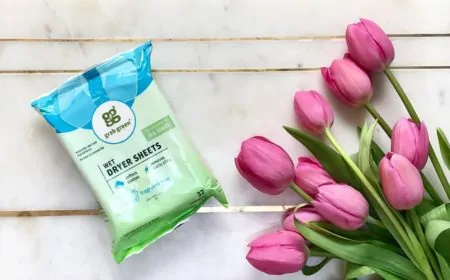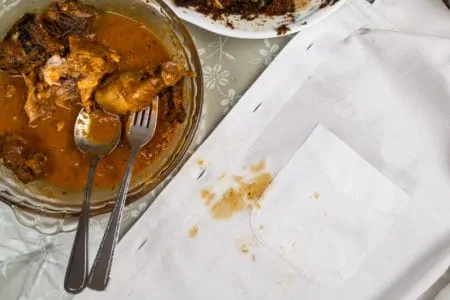To keep your washing machine working perfectly, clean and odor-free, it needs to be cleaned regularly. We’ll share exactly how to clean your washing machine with and without bleach.
Whether you have a front-loading or top-loading machine — this advice will get it clean. In the end, your clothes will be cleaner, too!
Key Takeaways
- Clean your washing machine once a month to remove odors, detergent residue, dirt, and bacteria.
- For front-loading washers, clean the rubber gasket, detergent drawer, and filter before running a hot cycle with your chosen cleaning solution.
- For top-loading machines, fill with hot water, add cleaning solution, and clean all surfaces before running a final rinse and spin cycle.
- Use vinegar, baking soda, or bleach as cleaning solutions, but never mix vinegar and bleach together.
- Do Washing Machines Need to Be Cleaned?
- How to Clean Your Washing Machine
- How to Clean Your Washing Machine With Vinegar
- How to Clean Your Washing Machine With Baking Soda
- How to Clean Your Washing Machine With Bleach
- Why Does My Washing Machine Still Stink After Cleaning It?
- Should You Get a Cleaning Service to Deep Clean Your Washer?
- FAQs
- Clean Machine, Clean Clothes
Do Washing Machines Need to Be Cleaned?
Washing machines are subject to dirt, bacteria, germs and soap residue on a regular basis. Your detergent cleans your clothes, but not your machine. So you’ll need to do a separate clean of the washing machine from time to time.
How Often Should You Clean Your Washing Machine?
You should clean your washing machine once a month. Cleaning your machine regularly gets rid of musty odors, detergent residue, dirt and bacteria.
How to Clean Your Washing Machine
We’ll share tips on how to clean both a front-loading and top-loading washing machine. You can use the cleaning solution of your choice, which we’ll reference later. There are a few different solutions you can use depending on what you have in the cupboard.
Pro Tip
How to Clean a Front-Loading Washer
- Clean the rubber gasket: Take out any debris from it such as lint, coins, hair clips and whatever else builds up in there. Then wipe it down with a warm cloth and distilled white vinegar.
- Clean the detergent drawer: It should be removable. You can clean it in the sink with some washing liquid and an old toothbrush.
- Clean the filter: This is where more loose dirt and debris will go. Put a towel and bowl on the floor. Unplug the filter and let the water and debris drain into the bowl. When it’s empty, plug it again and wash the bowl. Toss the towel into the laundry basket.
- Add your desired cleaning solution to the detergent dispenser: Keep in mind that some washing machines do not require any solution. Be sure to read the manufacturer’s instructions.
- Wash the inside: Set it to a normal wash or a drum clean cycle using the hottest water possible. Make sure the drum is completely empty.
- Wipe the inside: When the cycle is finished, wipe down the inside of the drum with a dry cloth.
- Dry your machine: Keep the door slightly open to let it air dry completely.
- Clean the outside: Wipe down the front of your machine with a cloth and white vinegar, too.
By now, your machine should be sparkling clean and smelling better.
How to Clean a Top-Loading Machine
- Fill the machine with the hottest water possible on a normal wash.
- Add your cleaning solution to the water while it’s filling.
- Let the wash complete, then fill the machine with hot water again.
- Add your cleaning solution.
- Wearing rubber gloves, dip a rag into the hot water from the machine.
- Clean the entire surface of the machine. The body, the lid, the sides, under the lid, in the detergent dispensers — really get into every nook and cranny! If a rag doesn’t do the trick, use an old toothbrush.
- Do a final rinse and spin to get rid of any dirt and debris.
- Wipe dry with a cloth and leave the lid open for the machine to air.
How to Clean Your Washing Machine With Vinegar
Adding distilled white vinegar to your washing machine can break down dirt, buildup, stains, oils and bacteria (1). It’s 5% acidic which is why it is such an effective household cleaner.
To use for washer cleaning, add two cups to your detergent dispenser (for front-loading washers) or to the drum as it’s filling with water (for top-loading machines).
Pros
- Natural.
- Eco-friendly.
- Inexpensive.
- It’s acidic, therefore effective at cleaning.
- Safe around kids and pets.
- Chemical and toxin-free.
- It kills mold (2).
- It kills germs, bacteria and viruses.
Cons
- The acid might irritate your skin.
- It has a distinct smell (but this can be combated by using essential oils in your solution).
- Doesn’t cut through grease.
Caution
How to Clean Your Washing Machine With Baking Soda
Baking soda will work wonders in your washing machine. It kills odors and is slightly abrasive so it can help get rid of dirt, debris and build-up (4).
To use, pour half a cup of baking soda into the detergent dispenser (for front-loading machines) or directly into the drum as the water is filling (for top-loading machines).
Pros
- Natural.
- Eco-friendly.
- Inexpensive.
- It’s a mild alkali, so it dissolves dirt and grease (5).
- It neutralizes odors.
- It’s safe to use around kids and pets.
How to Clean Your Washing Machine With Bleach
Bleach is a common cleaner and disinfectant that you can use for your washing machine. However, you must follow manufacturer instructions and guidance to use it properly.
To use in your washing machine, use the recommended amount on the packaging instructions. In general, this will be about 60ml for front-loading machines added to the detergent dispenser. For top-loading machines, add up to a full cup to the drum as it fills with water. If you have a bleach dispenser, you can use this instead.
Tips for Using Bleach
- Wear protective gloves when handling bleach.
- Use the recommended amount. If this is different from our guidance, follow the package instructions.
- Keep out of reach from children and pets.
- Never mix it with other cleaning products.
- Always do an extra rinse to get rid of remaining bleach.
Pros
- It’s inexpensive.
- It removes stains.
- It kills germs, bacteria, fungi and viruses (8).
Cons
- Bleach fumes are toxic (9).
- If bleach comes in direct contact with your skin, it can burn or irritate it.
- People with asthma are particularly susceptible to lung irritation when using bleach.
Why Does My Washing Machine Still Stink After Cleaning It?
If you’ve followed all these steps and your washing machine still stinks — it could be down to a few reasons.
- Mold and mildew: Mold and mildew might still be prevalent after cleaning. Make sure to clean all the nooks and crannies of your machine. You might have to whip out the chlorine bleach here if vinegar or baking soda isn’t quite tackling the issue. Remember to look in the rubber gasket where mold and mildew sometimes hide.
- It needs deodorizing: If you have a washing machine that doesn’t require any cleaning solution when you use the drum clean cycle, then it’s not getting deodorized. You can skip that setting and just do a hot daily wash with white vinegar to deodorize your machine.
- Scrub away grime: Sometimes using these cleaning solutions alone isn’t enough to scrub away sticky grime. Before you do a cleaning cycle, get an abrasive cloth or sponge to scrub away grime inside the machine.
- Switch detergents: Many store-bought detergents and fabric softeners can build up on your clothes and inside your machine. Over time, your washing machine will start to smell. Opt for something more natural.
- Keep the drum dry: After you’ve washed your clothes, keep the door open to let the drum air dry or else it will develop a musty smell.
- You leave the clothes in too long: Everyone is guilty of this at some point or another. But it’s important to take your clothes out as soon as the cycle is done so that they don’t start to stink and create an odor in your machine.
Should You Get a Cleaning Service to Deep Clean Your Washer?
Washer cleaning is not a difficult task, but you may encounter complications. Perhaps you have a mold issue, a clogged filter or you just can’t get rid of the bad smell.
We truly believe with our tips and a bit of hard work, you can tackle these problems at home. But if for any reason it’s not working out, call a cleaning service! Some washing machine companies will offer this as part of your warranty as there might be an issue with the machine.
Look online for a cleaning service or call your machine manufacturer.
FAQs
Clean Machine, Clean Clothes
Ultimately, when you have a clean washing machine, your clothes will be much cleaner. That’s the end goal on laundry day, for sure.
You can use eco-friendly solutions such as baking soda or vinegar which will do a stellar job in deep cleaning your machine. However, if mold, mildew or bacteria is an issue in your washer, opt for bleach. Just make sure to wear protective gloves and clothing.
If all else fails — call a cleaning service and treat yourself to a deep clean of your machine.










